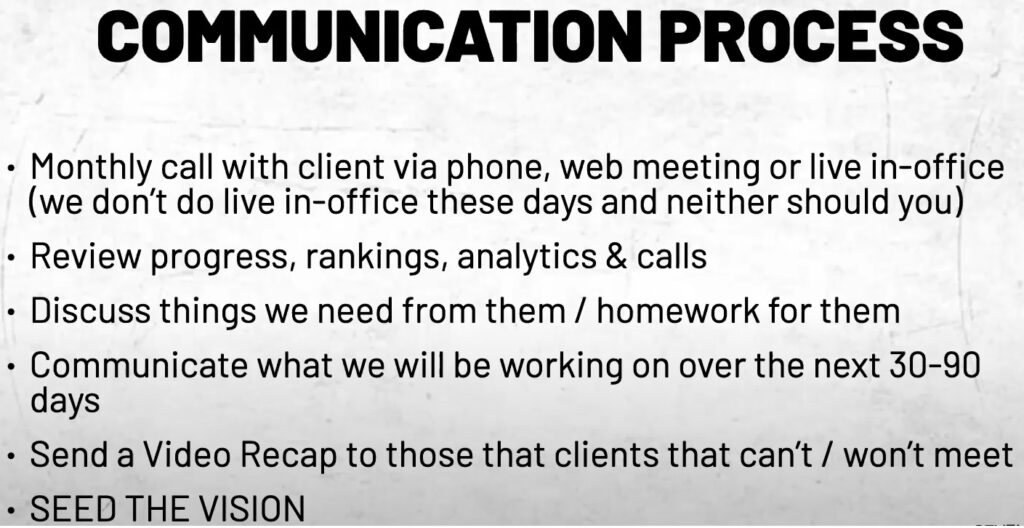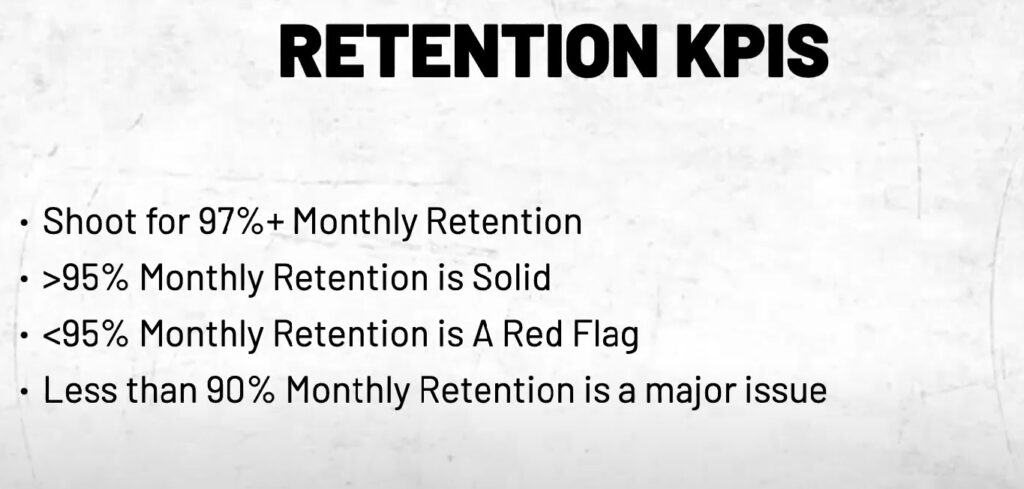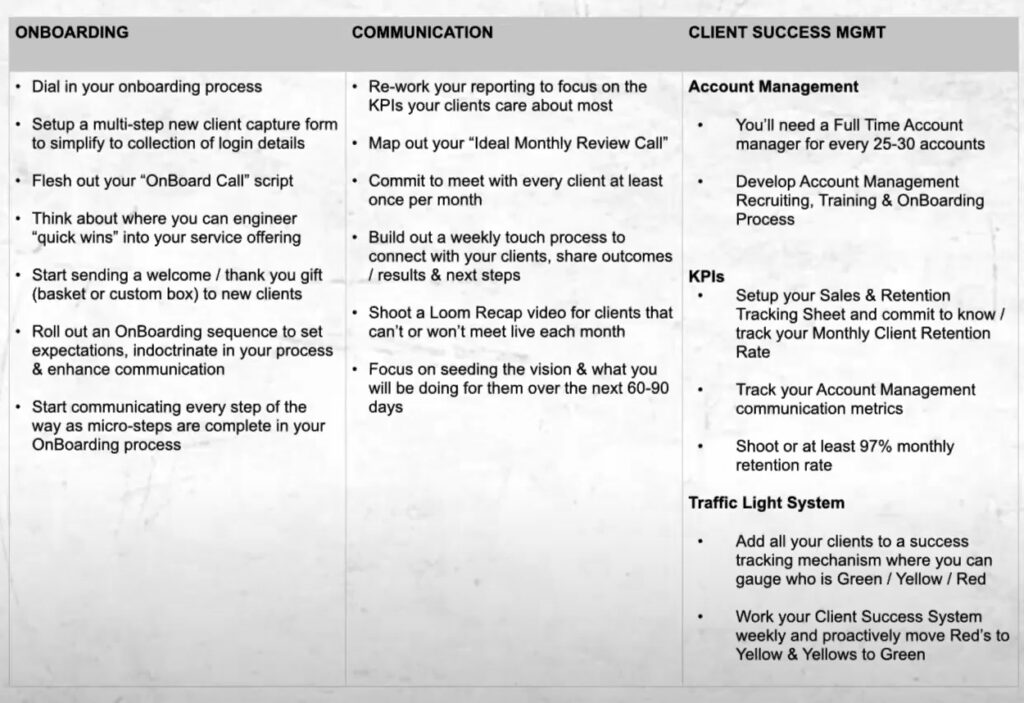Table of Contents
Introduction
Josh Nelson, the founder of the Seven Figure Agency, spoke about the strategies for retaining clients in the webinar on “How To Maximize Client Retention for your Digital Marketing Agency.”
One of the biggest challenges in running an agency is you get the clients, you pour yourself into it, and they cancel.
The Importance of Retaining Clients
BAIN did a really interesting study, and they found that a 5% increase in customer retention can improve your profits by 25 to 95%.
And so, digital agency owners are usually very focused on growth, landing more clients, grow the top line.
But the reality is just a marginal improvement in retaining clients for that extra 5, 6, or 12 months can significantly impact profitability.
The repercussions of low retention are:
- First of all, the wasteful effort of doing the work, hustling, and then losing the client, losing that recurrence of revenue;
- Negatively impact your reputation, especially if you’re a niche-focused agency;
- Negatively impact your confidence to go out and introduce your services and try and get new clients, and
- Inability to forecast for resources.
Why Do Clients Leave
Put another way, what’s the most challenging part of retaining clients? We want clients to come on board, be happy, and stick around long-term.
Many, especially early on in their agency journey, haven’t figured it out. But it’s usually a combination of not onboarding well, not having a good system to kick things off on the right path, misaligned expectations, and inadequate relationship management.
But the number one reason clients leave is not failed execution, lower results, or low ROI, but perceived indifference.
They leave because they feel you and your company don’t really care that much anymore. They feel like you’ve disengaged.
Steps for Retaining Clients
Focus on retention. It will make you more money and will make you more profitable. Start with some fundamentals, the key tenets of long-term client retention.
Focus on the Impact
Ensure that the services you provide actually drive a tangible, measurable return on investment. People are only going to pay so long as there is a positive ROI.
So frame your service offering in terms of what they’re going to spend and how much they get in return. Then, you’ve got the foundation for a good service that’s actually going to retain clients for the long term.
We also like to do things like sending clients their face on a pair of socks and a personal note as a way of showing we deeply care about our relationship with them.
Also – consider flying out to clients to record content for repurposing.
Go Wider
If you can go wider with your service offering, you can become a lot more sticky.
If you’re just doing Facebook ads, email automation, or selling software as a service, you basically have one foot in the door. However, if you come in and are focused on impact and provide a more comprehensive solution that’s going to actually get them what they want, which is more leads, more sales, and revenue, they’re going to have more reasons to stick with you.
If you continue to focus on impact, you’re not just adding additional services for the sake of retention, you’re adding additional services because you can control the outcome that the client gets.
Client Selection
It boils down to whether you are choosing to work with startups, the one-man operation that really doesn’t have its business fully fleshed out, or with the more established companies that are already successful and are just looking to accelerate things to the next level. The latter have the right systems in place, and they can pay your fee and get a good return on investment from the services.
A lot of people struggle with the idea of saying no, of turning down a client that’s ready to write the check. But in the grand scheme of things, it could really be a bad decision, to say the least.
Setting the Right Expectations
For instance, if you come into the relationship and frame it like, “Hey, let’s do a test. Let’s see how things go in the first 30 days. And then we’ll see where we are after that.” In the client’s mind, even if they’ve signed up, they’re thinking, “I give this two weeks, and if it’s not crushing it for me, I’m out.”
Instead, make it clear to the client that this is going to be a long-term business relationship, “This is what we’re going to do, and this is the result you can expect. But if we’re not going to commit to doing this together for the next 6,12, or 18 months, let’s not bother!”
If you frame it in that way, obviously, they’re going to be in for the long term and much more likely to stick around until things really pick up.
Effective Communication
Show the clients that you care, pay attention to them, send monthly reports, and check in with them on a consistent basis. That way, you can remove the number one cause of clients leaving, which is perceived indifference.
This is so powerful that even if you temporarily fail to deliver as per client expectations, this acts like a buffer, and the client will even be willing to look the other way and hang around with you.
The Results-Relationship Balance
And if either of these is out of balance, there’s a good chance that the clients will leave.
You can be crushing it for the client, getting tons of leads, tons of sales, and great results. But if they’re getting no relationship from you, they don’t feel like you care, you’re not checking in, you’re not showing the value, and you’re not presenting a great experience; eventually, the balance is going to tip out of favor for you, and the client’s going to leave.
On the flip side, let’s say you’ve got a great relationship. They love you,, they feel like you’re the best person they’ve ever dealt with, and they believe that you can deliver the goods; but at the end of the day, if the results aren’t there, over time, they’re going to wind up canceling anyways.
The Model to Address Perceived Indifference
In this model, there are three key things to focus on; onboarding, effective communication, and success management.

World Class Onboarding
If we can kick things off well out of the gates, it’s going to massively improve the chance that they’re with us three months, six months, or 12 months down the road. So getting world-class onboarding dialed in is really important.
If you get the following three things dialed in, it will have a huge impact in the first 60 to 90 days:
- Kick-off with a bang and appreciation. Send them something in the mail. Show them that we’re happy that they signed up with us. Map out the next week, 30 days, and 90 days to not only send out details but also to create an overall experience aimed at making them feel confident that they have placed this in the right hands;
- Seamlessly collect the data like login credentials, pictures, USP data for messaging, and so on, depending on the complexity of your service offering. Make that as simple as possible and take as much off of the client’s plate as you possibly can;
- Engineer quick wins. Strategically decide two or three things you can do in month one that will generate quick wins, like turning on the web chat widget or turning on GMB chat. That will generate some leads or generate revenue and get them excited that they’ve made this buying decision.
Effective Communication
How do we communicate with that client out of the gates and then, on a monthly basis? What are the reports we’re going through? How are we communicating? How are we pulsing to help them understand the value that we bring to the table and the reason that they’re with us in the first place?
- Strategic reporting and KPIs. Strategically finding the things that they need to see to determine if things are moving in the right direction. Consider the reason why they hired you and what outcome they are looking for. They are really not as interested in the technical mumbo-jumbo. Instead, their key KPI is the number of leads generated and the ROI. Drop these into a pipeline in the report. This is the future of digital agencies. So lead the report with the KPIs and have the other stuff like ranking reports and Google Analytics as a backdrop. ;
- Determine the meeting rhythm.
- How often should we be meeting with the client?
- What should we cover in those meetings?
- What do we do when they don’t show up?
- How do we keep that relationship active if we get a retainer fee of $1,000 to $2,000 monthly or more?
- Seed the vision. There’s so much competition in this space that if you’re not constantly saying, “Hey, here’s what we’ve done, and here’s where we’re headed over the next three to six months,” they’re going to start to look at the grass across the way that’s a little bit greener. So, continually recapping and mapping.
- Communicating every step of the way. Let them know all of the little minuscule tasks that you create, that you accomplished. And instead of them feeling like you went radio silent, they’ll feel like, man, these guys are overcommunicating. These guys are on top of the ball. These guys are amazing. You’re going to do the same amount of work, but the clients will be much happier.
- Ongoing customer communication process –
- Monthly call with clients (via phone, web meeting or live meeting);
- Review progress, rankings, analytics, and calls;
- Discuss things you need from them;
- Communicate what you will be working on over the next 30-90 days;
- Send a video recap of the meeting, and again,
- Seed the vision.

Success Management
As your agency goes from 10 to 15 clients to a hundred plus clients, you really have to have a strategy and a system for success management.
How do we still have that relationship? When there are hundreds of clients how do we show that we care and avoid perceived indifference?
- Track client churn rates. We have to know month over month, quarter over quarter, year over year, how are we doing? How many clients are we gaining? How many are we losing? What’s our retention rate? What’s our churn rate? We really have to know that number. You could have a sales and retention tracking sheet to track how many clients did you get, what were your goals and targets, and how many did you lose? What’s your retention rate?
- Have some strategic KPIs that we’re looking at from your account management team to keep a pulse on them and the fact that they’re doing things right to maximize the retention rates.
- Have a traffic light system. When you’ve got hundreds of clients, it can be hard to see who’s happy, who’s sad, and who’s about to run out the door. If you can drop your clients on a pipeline and just say, all right, here’s my greens. These clients are checking in for the monthly meetings and are happy with the results. Here are our clients that are yellow, which means they’re not showing up or something’s not quite right. Those are clients in the reds. They’re just getting no results. They’ve just threatened to cancel. So, put them in a pipeline. That way, from a snapshot, you can visually see where your clients sit, and then you can manage that.
- Hire accounts managers. As the owner, if you are doing all of it yourself, you’re going to cap out about 10 to 15 accounts. And so at that point, you have to then hire an account manager or a client success person. On average client success manager can handle between 25 to 30 accounts. And then for every 20 to 25 additional clients, you will hire another account manager.
The five principles to bear in mind are:
- Measure what matters
- Keep a bird’s eye pulse on all accounts;
- Get ahead of the issues;
- Prioritize the most at need, and
- Take proactive weekly actions.
The Initial 10 Touchpoints
This is in Josh’s workbook, where you can fill it in. You don’t have to use our exact steps here, but this will help you think through what those steps could be and how you could bridge the gap:
- As soon as they sign up, they get a personal thank you in their inbox, and it should feel like a real personalized message from the owner via email, social messenger, or even a personalized video recording;
- Get the onboard form into their hands so that if they know some of those key details and have the energy to fill it in, they can do some of that work right out of the gates;
- Have a welcome sequence with contingency pieces built it if the client is still not ready to move to the next step.
While most digital marketing agencies have great sequences on the front end to get prospects to raise their hand, get them to schedule in, and ultimately sign up and become agency clients, almost none have a sequence of communication after the client signs up. - Have a structured launch call within the first couple of days of signing up. A structured scripted conversation, just like you would in your sales process, can be a huge advantage. How do you reset expectations? How do you resell them on the investment they’ve just made? How do you set the long-term vision for the relationship together and at the same time get the username passwords and set some landmines and make sure that you’ve preceded those landmines or dealt with them in advance;
- Send a gift basket with like chocolates and goodies, maybe a bottle of wine, within three to five days of signing up that shows up in their mail. It’s like the cherry on top. The client will think, these guys just keep getting better and better. Things are going well as far as I could expect from a marketing company, but now all of a sudden I’ve got chocolates and wine. it’s unexpected and has a different feel to it;
- Launch the PPC campaign including database reactivation to reach past customers within the first seven to fourteen days. Drive traffic straight to a landing page, and start to drive visitors and leads. So that at this point they should be able to start to see some results. They should start to see not a windfall of lead flow but something tangible where they’re like, okay, this was a great experience, and now I’m already starting to see some results from the activity;
- Set your clients up on review tracking so we can show them, “Hey, here’s how many reviews you have, and here’s how many reviews your next closest competition has.” Formulate that not just into something you run in the background but as a structured conversation;
- In week two, the client should get the design composition. If you’ve set up a high level for them, maybe earlier in this process, you want to show them here’s how it works.
- Show them those tools and the other things that you’re implementing for them that they can sink their teeth into;
- Launch their website by the sixth week.
Retention KPIs
If you don’t know what you’re shooting for, you don’t know what’s good, and you don’t know what’s bad., in these types of agency services, it’s been found that shooting for about a 97% monthly retention rate is solid. You may look at that and think that’s terrible because you’re losing clients every month when you’re at 150 or so clients, but the reality is clients are going to leave.
Above 95%, you’re doing pretty well. But when it starts to get less than 90%, it’s a red flag. It’s time to go back to the drawing board. Something needs to change. You probably want to start paying closer attention either to the promise you’re making, the onboard experience, and the monthly reporting.

But a very important thing to consider when you are looking at these KPIs is whether the client, though he has discontinued some of your services, is still continuing with the more lucrative services that you are providing. So despite a reduction in services, you still have the client who is using your service that has a very high contribution to your gross margin.
Conclusion
So to recap:

